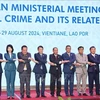Poverty reduction efforts in Ho Chi Minh City has produced encouraging outcomes over the past 20 years, paving the way for achieving sustainable poverty elimination.
Poverty alleviation models have been implemented via practical measures such as capital for business, vocational training, job placement and health insurance. Meanwhile, comprehensive solutions are also carried out to help the impoverished to increase their income.
On the outset of 2014, the city fulfilled the third phase of poverty reduction programme (2009-2015) bringing the rate of households living under poverty line of below 12 million VND (562 USD) per capita a year to just 0.57 percent.
By the end of 2014, the city completed its target for the fourth phase of the programme one year ahead of schedule when the rate of poor families was reduced to 1.45 percent based on the revised poverty line of 16 million VND per capita a year, from the rate of 4.23 percent when the phase began.
However, more practical measures are needed to make the achievements more sustainable, said Hua Ngoc Thuan, Vice Chairman of the municipal People’s Committee, adding that poverty assessment by income cannot reflect other aspects in the residents’ lives such as housing conditions and access to healthcare, fresh water and hygiene.
Recently, the city has coordinated with the UN Development Programme (UNDP) to build projects on assessing poverty conditions in Hanoi and Ho Chi Minh City and supporting multi-dimensional poverty alleviation in urban areas in a bid to build up sustainable poverty alleviation policies.
The city has piloted poverty measurements based on the multi-dimensional approach with the goal of adopting multi-dimensional poverty standards for the next phase of its poverty reduction programme from 2016-2020.-VNA
Poverty alleviation models have been implemented via practical measures such as capital for business, vocational training, job placement and health insurance. Meanwhile, comprehensive solutions are also carried out to help the impoverished to increase their income.
On the outset of 2014, the city fulfilled the third phase of poverty reduction programme (2009-2015) bringing the rate of households living under poverty line of below 12 million VND (562 USD) per capita a year to just 0.57 percent.
By the end of 2014, the city completed its target for the fourth phase of the programme one year ahead of schedule when the rate of poor families was reduced to 1.45 percent based on the revised poverty line of 16 million VND per capita a year, from the rate of 4.23 percent when the phase began.
However, more practical measures are needed to make the achievements more sustainable, said Hua Ngoc Thuan, Vice Chairman of the municipal People’s Committee, adding that poverty assessment by income cannot reflect other aspects in the residents’ lives such as housing conditions and access to healthcare, fresh water and hygiene.
Recently, the city has coordinated with the UN Development Programme (UNDP) to build projects on assessing poverty conditions in Hanoi and Ho Chi Minh City and supporting multi-dimensional poverty alleviation in urban areas in a bid to build up sustainable poverty alleviation policies.
The city has piloted poverty measurements based on the multi-dimensional approach with the goal of adopting multi-dimensional poverty standards for the next phase of its poverty reduction programme from 2016-2020.-VNA



















